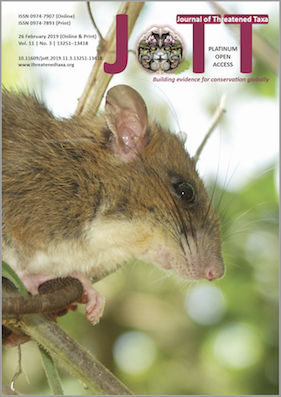New record of Blue-eyed Eastern Spadefoot Toad Leptobrachium bompu (Amphibia: Megophryidae) from Sarpang District in Bhutan
DOI:
https://doi.org/10.11609/jott.4134.11.3.13385-13389Keywords:
Habitat, Jigmecholing, litter frogs, Megophryids, morphometric measurement, Simkhar watershedAbstract
This study provides the first report of Leptobrachium bompu Sondhi & Ohler, 2011 from Bhutan. The species was recorded from Simkhar watershed in Jigmecholing under Sarpang District, at an elevation of 1,610m. Simkhar Stream is small and perennial, shaded and swampy, with a few moss-laden flat stones along the course, and is pollution-free and slow-flowing. The current report extends the distribution record of L. bompu towards the east and will help in understanding the range and conservation status of the species.
References
Champion, F.W. & S.K. Seth (1968). A Revised Survey of Forest Types of India. Government of India Press, Nasik, India, 404pp.
Frost D. R. (2016). Amphibian Species of the World: An Online Reference. Version 6.0 (accessed on 8th November 2016). American Museum of Natural History, New York, USA. Electronic Database accessible at http://research.amnh.org/herpetology/amphibia/index.html
Frost, D.R. (2019). Amphibian Species of the World: An Online Reference. Version 6.0. American Museum of Natural History, New York, USA. Accessed on 10 January 2019. Electronic database accessible at http://research.amnh.org/herpetology/amphibia/index.html
Gurung, D.B., Ugyen & D. Tshering (2012). Mon-paa Frog Survey Report from Mithun village (24–27 April 2012) under Dophuchen, Samtse District. Unpublished Technical Report. District Forestry Sector, Samtse, Bhutan, 30pp.
Liang, X., W. Liu, B. Wang, L. Ding., J. Wu, F. Xie & J. Jiang (2017). Leptobrachium bompu (Amphibia, Anura, Megophryidae) discovered in Upper Medog, Tibet, China with descriptions of its tadpoles, advertisement calls and systematic position. Asian Herpetological Research 8(2): 137–146; https://doi.org/10.16373/j.cnki.ahr.160023
Oshawa, M. (1987). Vegetation zones in the Bhutan Himalaya, pp1–71. In: Oshawa, M. (ed.). Life Zone Ecology of the Bhutan Himalaya. Yayoicho, Chiba University, Japan, 206pp.
Saikia, B., B. Sinha & I.J. Kharkongor (2017). A second record of the Eastern Spadefoot Toad (Amphibia: Anura: Megophryidae: Leptobrachium bompu Sondhi & Ohler, 2011) with a note on its morphological variations and natural history. Journal of Threatened Taxa 9(9): 10692–10696; https://doi.org/10.11609/jott.3300.9.9.10692-10696
Sondhi, S. & A. Ohler (2011). A blue-eyed Leptobrachium (Anura: Megophrydaie) from Arunachal Pradesh. Zootaxa 2912: 28–36.
Tenzin, J. & P. Dhendup (2017). Habitat characteristics, relative abundance and conservation threats of Himalayan Bull Frogs (Nanorana leibigii Gunther, 1860) in primary tributaries of Simkhar River, Bhutan. Journal of Natural Resources and Development 4(2): 29–38; https://doi.org/10.17102/cnr.2017.07
Tenzin, J., P. Dhendup, K. Choki & T. Dorji (2018). Sarpang: At a Glance. Divisional Forest Office, Sarpang, Department of Forests and Park Services, Ministry of Agriculture & Forests, Thimphu, Bhutan, 8pp.
Tschudi, J.J. (1838). Classification der Batrachier, mit Beruckischtigung der fossilen thiere dieser Abtheilung der Reptilien. Petitpierre, Neuchatel, ii+98pp+6pl.
Wangyal, J.T. (2014). The status of herpetofauna of Bhutan. Journal of the Bhutan Ecological Society 2(1): 20–39.
WWF (2015). Hidden Himalayas: Asia’s Wonderland - New Species Discoveries in Eastern Himalayas, Vol. II, 2009–2014 WWF Report: Living Himalayas. WWF Bhutan, Thimphu, Bhutan, 43pp.
Zweifel, R.G. (1998). Frogs and toads, pp.76–105. In: Cogger, H.G. & R.G. Zweifel (eds.). Encyclopedia of Reptiles and Amphibians. Academic Press, San Diego, 88pp.
Published
Issue
Section
License
Authors own the copyright to the articles published in JoTT. This is indicated explicitly in each publication. The authors grant permission to the publisher Wildlife Information Liaison Development (WILD) Society to publish the article in the Journal of Threatened Taxa. The authors recognize WILD as the original publisher, and to sell hard copies of the Journal and article to any buyer. JoTT is registered under the Creative Commons Attribution 4.0 International License (CC BY), which allows authors to retain copyright ownership. Under this license the authors allow anyone to download, cite, use the data, modify, reprint, copy and distribute provided the authors and source of publication are credited through appropriate citations (e.g., Son et al. (2016). Bats (Mammalia: Chiroptera) of the southeastern Truong Son Mountains, Quang Ngai Province, Vietnam. Journal of Threatened Taxa 8(7): 8953–8969. https://doi.org/10.11609/jott.2785.8.7.8953-8969). Users of the data do not require specific permission from the authors or the publisher.





